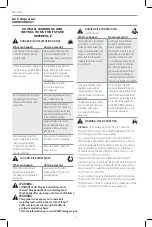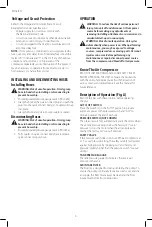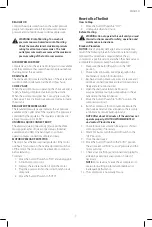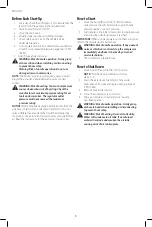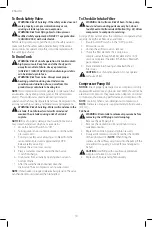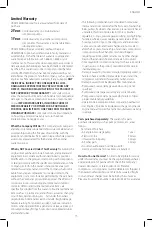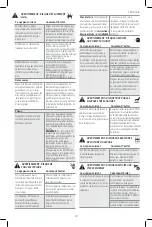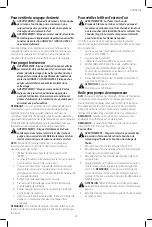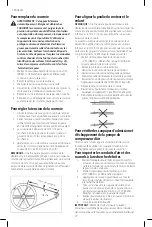
12
ENGLISH
To Check Air Compressor Pump Head
Bolt Torque
The air compressor pump head bolts should be kept properly
torqued. Check the torques of the head bolts after the first five
hours of operation. Torque to 15-20 ft.-lbs. (20.3-27.1 Nm).
SERVICE AND ADJUSTMENTS
ALL MAINTENANCE AND REPAIR OPERATIONS NOT LISTED
MUST BE PERFORMED BY TRAINED SERVICE TECHNICIAN.
WARNING: Risk of unsafe operation. Unit cycles
automatically when power is on. When servicing,
you may be exposed to voltage sources,
compressed air, or moving parts. Before servicing
unit unplug or disconnect electrical supply to the
air compressor, bleed tank of pressure, and allow
the air compressor to cool.
To Replace or Clean Check Valve
1. Release all air pressure from air tank. See Draining
Air Tank in the Maintenance section.
2. Move the Auto/Off switch to "Off", unplug the unit,
and relieve all air pressure from the air tank.
3. Using an adjustable wrench loosen outlet tube nut
at air tank and pump. Carefully move outlet tube
away from check valve.
4. Using an adjustable wrench loosen pressure relief
tube nut at air tank. Carefully move pressure relief
tube away from check valve.
5. Unscrew the check valve (turn counterclockwise)
using a 13/16" open end wrench. Note the
orientation for reassembly.
6. Using a screwdriver, carefully push the valve disc
up and down.
NOTE:
The valve disc should move freely up and down on a
spring which holds the valve disc in the closed position, if not,
the check valve needs to be cleaned or replaced.
7. Clean or replace the check valve. A solvent, such as
paint or varnish remover can be used to clean the
check valve.
8. Apply sealant to the check valve threads. Reinstall
the check valve (turn clockwise) to proper
orientation.
9. Replace the pressure release tube. Tighten nuts.
10. Replace the outlet tube and tighten nuts.
11. Perform the Break-in Procedure. See Break-in
Procedure in the Operation section.
Cleaning
WARNING: Blow dirt and dust out of all air vents
with clean, dry air at least once a week. To
minimize the risk of eye injury, always wear
ANSIZ87.1 approved eye protection when
performing this.
WARNING: Never use solvents or other harsh
chemicals for cleaning the non-metallic parts of
the tool. These chemicals may weaken the plastic
materials used in these parts. Use a cloth
dampened only with water and mild soap. Never
let any liquid get inside the tool; never immerse
any part of the tool into a liquid.
Repairs
WARNING: To assure product SAFETY and
RELIABILITY, repairs, maintenance and
adjustment (including brush inspection and
replacement, when applicable) should be
performed by a CRAFTSMAN authorized service
center. Always use identical replacement parts.
Storage
Before you store the air compressor, make sure you do the
following:
1. Review the
Maintenance
section on the
proceeding pages and perform scheduled
maintenance as necessary.
2. Drain water from air tank.
See To Drain Tank
under
Maintenance
.
WARNING: Water will condense in the air tank. If
not drained, water will corrode and weaken the
air tank causing a risk of air tank rupture.
3. Protect the electrical cord and air hose from
damage (such as being stepped on or run over.
Wind air hose and electrical cord loosely around
compressor handle).
4. Store the air compressor in a clean and dry location.




